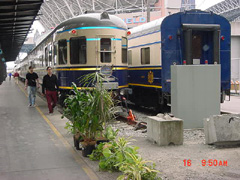![[Previous Page]](http://www.atdlines.com/images/previous.gif)
| |||||

|

|

|

|

In 1952, the Chesapeake and Ohio (C&O)'s Kenneth A. Brown conceived the idea of roadrailers. After development was complete, the C&O began to use 29', single-axle trailers beginning in 1955 and ran them in service between Detroit and Grand Rapids, MI. The new type of trailers were attached to C&O's passenger trains and were utilized to haul mail and express service. The C&O was now able to provide rail access to new customers who did not have, or want to build, actual rail siding. The use of this new type of rail service continued into the early 1960's until being discontinued. In the 1980's, railroads began to look for innovation, and the roadrailer concept was dusted off and again put to limited use. The Illinois Central Gulf was most prominent in this rebirth of roadrailer technology, however Family Lines, Seaboard Coast Lines, and Union Pacific also utilized the unique trailers. Roadrailer trailers have had quite an evolution from the initial 29' trailers used by the C&O. The Roadrailer technology was formally purchased by Wabash National Corporation, of Lafayete, IN, in 1991, although it produced its first Roadrailer in 1987. Over the years, the trailers have transformed themselves from Mark IIs to Mark IV, to Mark V, complete with detachable train-wheel-bogies. Roadrailer dry vans feature the following:Low Tare WeightMaximum Interior Dimensions High Strength Construction Air-Ride on Highway Slack Free Coupling Maximum Cargo Security Rail Brake System Specifications:Overall Length 53 feetOverall Height 13' 6" on 47" fifth wheel Overall Width 102 3/8" Inside Length 52' 5-1/2" Inside Height 110" [front] / 112 1/4" [rear] Inside Width 101 1/4" Cubic Capacity 4,066 cubic feet Kingpin Location 36" However, roadrailer technology received its greatest use when Norfolk Southern (NS) began its use of roadrailers, and created its now famous Triple Crown Service (TCS) subsidiary in 1986. In 1993 and greatly impressed with the success Norfolk Southern had, Conrail joined TCS as an equal partner. In 1997, the Burlington Northern Santa Fe Railway (BNSF) joined the TCS Network, providing service for Triple Crown Roadrailers between Kansas City, KS and Saginaw, TX. BNSF's Roadrailer trains began running on 18 August 1997 with the first train symboled the Q-KCKSAG1-18, with ATSF GP60M #156 leading 15 trailers south from Kansas City to Saginaw. The northbound equivalent was symboled the Q-SAGKCK. However the current symbols are Q-KCKFTW and Q-FTWKCM. Why the difference between the modern symbols with regards to the Kansas City destination? Norfolk Southern delivers the trailers for interchange to BNSF in Kansas City, KS, (symboled the T-KCKNS-3R1) however BNSF interchanges trailers back to NS in Kansas City, Missouri. Delivery to BNSF is at Argentine, KS from NS and are straight run-through trains which originate in Pennsylvania and Ohio. BNSF delivers Roadrailers to Norfolk Southern's yard in North Kansas City, MO. The BNSF TCS Roadrailer trains were originally operated four days per week, however in late 2001, a fifth operational day was added. Westbounds (compass south) operate Monday, Wednesday, Thursday, and Friday, while Eastbounds (compass north) operate Monday, Tuesday, Wednesday, Friday and Saturday. BNSF experimented with an auto parts Roadrailer train from Laredo, TX to a facility outside of Mexico City, Mexico, however service has not continued. Currently as of 21 November 2003, Norfolk Southern power is to run through with the BNSF Roadrailer trains to Fort Worth, TX, and will run on BNSF tracks between Argentine Yard to W.B. Junction at Carrollton, MO. BNSF and NS now interchange all RoadRailer equipment in Argentine Yard, and the new BNSF Roadrailer train symbols are Q-KCKFTW (Kansas City, KS to Ft. Worth, TX) and Q-FTWKCK (Ft. Worth, TX to Kansas City, KS). |
|
NATIONAL ROADRAILER FREIGHT SERVICE DIRECTORY
|
|
|
| | |
 AMERICAN TRAIN DESTINATION LINES
RAILWAY CITY ITINERARY PLANNING SERVICES
ROADRAILER HISTORY AND NATIONAL RAILWAY SERVICES
All Inquires submitted To: railwaynews@usa.com 206-780-6885
AMERICAN TRAIN DESTINATION LINES
RAILWAY CITY ITINERARY PLANNING SERVICES
ROADRAILER HISTORY AND NATIONAL RAILWAY SERVICES
All Inquires submitted To: railwaynews@usa.com 206-780-6885
![[Email Us]](http://www.atdlines.com/images/mailbutn.gif)
![[Return to Top]](http://www.atdlines.com/images/up.gif)
![Crossing Gate]](http://www.atdlines.com/motion/train6.gif)
![Power By ETS]](http://www.atdlines.com/images/power.gif)
